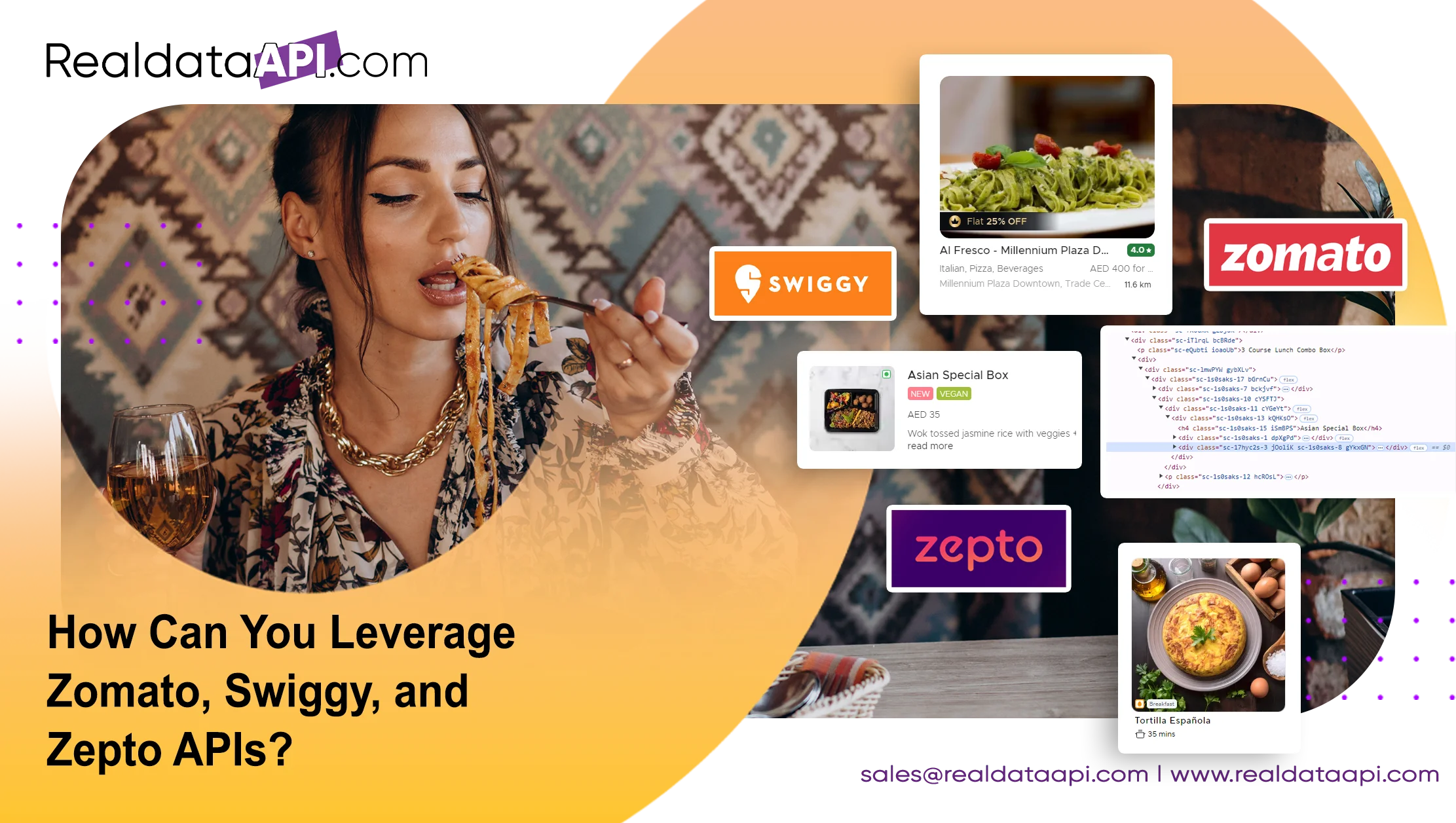.webp)

Introduction
In today’s competitive landscape, leveraging APIs for food and delivery data can provide a significant edge. Zomato, Swiggy, and Zepto as major players in the food delivery and grocery sectors, offer APIs that can be pivotal for businesses seeking to optimize their operations, improve customer engagement, and drive strategic decisions. This blog explores how to effectively use food and delivery data scraping services and their APIs to harness data for enhanced business outcomes.
Understanding the Value of Food and Delivery Data APIs

APIs (Application Programming Interfaces) offer a structured way to interact with web services, allowing businesses to access and use data from platforms like Zomato, Swiggy, and Zepto. By integrating these APIs into your systems, you can:
Access Comprehensive Data: Obtain detailed information on restaurants, menu items, delivery options, pricing, and more.
Enhance Customer Insights: Understand customer preferences, behaviors, and trends through detailed analytics.
Optimize Operations: Improve inventory management, delivery logistics, and pricing strategies.
Zomato’s Scraping API

Zomato's Scraping API provides extensive access to restaurant data, including restaurant details, user reviews, ratings, and menu items. Key features include:
Restaurant Listings: Retrieve data on restaurant names, locations, cuisines, and operating hours.
Menu Information: Access detailed menu items with descriptions, prices, and images.
User Reviews and Ratings: Collect customer feedback and ratings to analyze restaurant performance.
Use Cases:
Market Research: Analyze restaurant trends and customer preferences.
Competitive Analysis: Compare your restaurant offerings with competitors.
Personalized Recommendations: Develop recommendation engines based on user reviews and ratings.
Swiggy Scraping API

Swiggy Scraping API offers valuable data related to food delivery services, restaurant details, and delivery logistics. Key features include:
Restaurant and Menu Data: Access comprehensive details about restaurants, their menus, and pricing.
Delivery Information: Get real-time data on delivery times, availability, and costs.
Promotions and Offers: Retrieve information on ongoing deals and discounts.
Use Cases:
Dynamic Pricing: Adjust your pricing strategies based on competitor offers.
Operational Efficiency: Improve delivery logistics and manage inventory more effectively.
Customer Engagement: Use promotional data to tailor marketing campaigns and increase customer retention.
Zepto’s Scraping API

Zepto’s Scraping API is designed for quick grocery delivery, providing data on products, prices, and availability. Key features include:
Product Listings: Access a wide range of grocery items with details on product categories, prices, and availability.
Price Comparison: Compare prices across different products and retailers.
Delivery Times: Retrieve data on estimated delivery times and locations served.
Use Cases:
Price Optimization: Monitor and adjust prices based on real-time data.
Inventory Management: Keep track of stock levels and product availability.
Market Trends: Analyze purchasing trends and adjust product offerings accordingly.
Blinkit’s Scraping API

Blinkit’s Scraping API provides data for rapid grocery delivery services, offering insights into product listings and delivery operations. Key features include:
Grocery Data: Access detailed information on grocery items, including categories, prices, and promotions
Delivery Tracking: Monitor delivery status and logistics.
Customer Preferences: Gather data on popular products and shopping patterns.
Use Cases:
Demand Forecasting: Predict future demand for products based on historical data.
Customer Personalization: Tailor offers and recommendations based on shopping patterns.
Competitive Insights: Compare product offerings and pricing with competitors.
Implementing API Integration

To leverage these APIs effectively, follow these steps:
Obtain API Keys: Sign up for API access through the respective platforms to get your API keys.
Develop API Integrations: Use programming languages like Python, JavaScript, or Ruby to build integrations with the APIs.
Handle Data Extraction: Utilize the APIs to extract and process data, ensuring it meets your business needs.
Ensure Compliance: Adhere to the usage policies and terms of service provided by each API provider.
Best Practices for Using APIs

Data Accuracy: Regularly verify the accuracy and completeness of the data retrieved.
Performance Optimization: Optimize API calls to ensure efficient data retrieval and processing.
Scalability: Design your integration to handle large volumes of data and traffic.
Security: Implement robust security measures to protect your API keys and data.
Conclusion
Leveraging food and delivery data scraping services with Zomato, Swiggy, Zepto, and Blinkit APIs can provide invaluable data for enhancing your business strategies. By integrating these APIs into your systems, you can gain insights into market trends, optimize pricing, improve operational efficiency, and engage with customers more effectively.
For businesses looking to take advantage of these data sources, it’s essential to choose the right APIs, follow best practices, and ensure compliance with platform policies. By doing so, you can harness the power of real-time data to drive growth and stay competitive in the fast- paced food and grocery delivery market.
For professional support in integrating and utilizing these APIs, consider exploring Real Data API. Our expertise in data scraping and API integration can help you unlock the full potential of your data and drive your business forward.
Contact Real Data API today to start leveraging powerful APIs and elevate your data-driven strategies.













